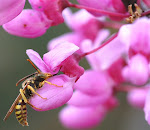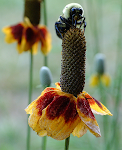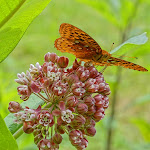from http://basicbeekeeping.blogspot.com/
LESSON 66: Screen Bottom Boards In The Winter & Fall & Winter Feeding
In a previous lesson, I shared several approaches on how to prepare for winter. In this lesson I want to go into more detail about screen bottom boards and winter feeding.
 Screen bottom boards prove to be very beneficial in the summer for reducing mites and for increasing ventilation. But do they pose a threat to a colony during the winter? That's a debated issue. Some cover their screen bottom boards while others leave them open. A few years ago, we did a simple test. We placed covers over 3 colony's screen bottom board and left the others open. We lost all three that were covered. So we always leave our screen bottom boards open all winter. It is our opinion that an open screen bottom board cuts down on excessive moisture. Cold air sinks and warm air rises, so the threat of an open screen bottom board, in our opinion, is minimal.
Screen bottom boards prove to be very beneficial in the summer for reducing mites and for increasing ventilation. But do they pose a threat to a colony during the winter? That's a debated issue. Some cover their screen bottom boards while others leave them open. A few years ago, we did a simple test. We placed covers over 3 colony's screen bottom board and left the others open. We lost all three that were covered. So we always leave our screen bottom boards open all winter. It is our opinion that an open screen bottom board cuts down on excessive moisture. Cold air sinks and warm air rises, so the threat of an open screen bottom board, in our opinion, is minimal.If your hive is up in the air 6 or 8 inches, then you want to prevent cold wind from curling up and blowing onto the cluster. This can be accomplished by building a wind block around your hive.
Remember, that a winter cluster warms only the cluster and not the inside of the hive. On an extremely cold night, the air several inches away from the cluster will be the same as outside the hive. The bees consume honey, and vibrate by flexing their muscles to generate heat, much like we do when we shiver. That heat is transferred throughout the cluster. They will be able to accomplish generating the cluster heat with or without the screen covered.
WHAT ABOUT WINTER FEEDING?
Many beekeepers allow their colonies to become extremely undernourished. Pollen and stored honey is essential to winter survival of colonies. In the fall, I work to beef up my colonies. It's tricky for me because of the number of colonies in one location. Even an inside top feeder can create a robbing frenzy. In the fall, boardman feeders placed in the front of hives is a certain robbing disaster.
So my approach is two fold. 1) During the fall only, after most nectar is no longer available, I want to prevent robbing, and 2) I want to beef up my colony nutrition for winter.

You can click on the images for a larger view. My approach is simple. I do use boardman feeders, but I place them on stands throughout the bee yard. And on dry days, I pour dry pollen out on the feed stands. My sugar mix is two parts sugar and one part water for fall. I have to make the holes bigger in the lids for the syrup to pass through. I also add one teaspoon of Honey-B-Healthy. Also, notice the bees on top of the jars? I make sugar patties too.
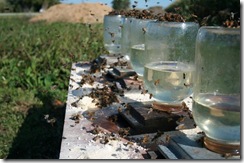 I mix sugar syrup with powdered sugar until it mixes a little stiffer than play dough. The bees love these sugar patties. I placed one on the top of each jar as you can see in the picture.
I mix sugar syrup with powdered sugar until it mixes a little stiffer than play dough. The bees love these sugar patties. I placed one on the top of each jar as you can see in the picture.So my fall feeding consist of dry pollen, hard sugar patties and 2:1 sugar syrup. Several people have asked me what 2:1 sugar means in measurements. I fill a gallon jar with between 32-48 ounces of very hot water. Then, I add sugar until it reaches the top which is around 7-8 pounds. Then stir it up. I will continue this type of feeding until the bees are clustered for winter.
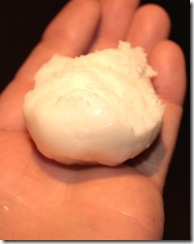 Another very effective winter feeding method is to make the sugar patties I mentioned above and lay on the tops of frames just above the cluster. Because it is a solid sugar feed, you do not have to worry about it freezing. The heat of the cluster will keep it warm and eatable.
Another very effective winter feeding method is to make the sugar patties I mentioned above and lay on the tops of frames just above the cluster. Because it is a solid sugar feed, you do not have to worry about it freezing. The heat of the cluster will keep it warm and eatable.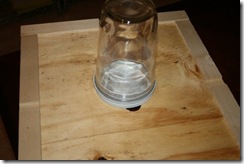 As the weather warms up above freezing, you can place pale feeders in the hive. I sometimes place jars of sugar water over the inner cover hole and then place a deep hive body without the frames so that the bees can consume the sugar water when it warms enough for the bees to break cluster. The deep hive body serves as a spacer around the jar. The top cover goes above the deep hive body spacer.
As the weather warms up above freezing, you can place pale feeders in the hive. I sometimes place jars of sugar water over the inner cover hole and then place a deep hive body without the frames so that the bees can consume the sugar water when it warms enough for the bees to break cluster. The deep hive body serves as a spacer around the jar. The top cover goes above the deep hive body spacer.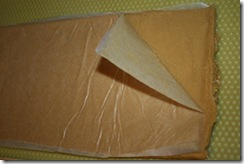 Another important feed application is that of internal pollen patties. If pollen sources are low within a colony, brood patties should be placed above the cluster. Again, on warmer winter days, the cluster will loosen enough so that bees can feed upon the pollen patties which contain a pollen substitute allowing the bees to consume the protein, vitamins, lipids and amino acids they need. ALWAYS leave the wax paper on the patty. The bees will eat around it, and usually they consume the paper too. If you remove the wax paper, the patty can become moldy and too gooey and fall between the frames.
Another important feed application is that of internal pollen patties. If pollen sources are low within a colony, brood patties should be placed above the cluster. Again, on warmer winter days, the cluster will loosen enough so that bees can feed upon the pollen patties which contain a pollen substitute allowing the bees to consume the protein, vitamins, lipids and amino acids they need. ALWAYS leave the wax paper on the patty. The bees will eat around it, and usually they consume the paper too. If you remove the wax paper, the patty can become moldy and too gooey and fall between the frames.We do sell the sugar patties, pollen patties as well as the screen bottom boards. Give us a call if you need these items or other beekeeping items.
 As we head for the end of the year, I do want to remind everyone that each year we raise our prices on January 1. We are currently offering our complete hive, which consists of a screen bottom board, two deep hive bodies with frames and foundation, one medium super with frames and foundation, an inner cover and a telescoping top cover with aluminum for $179. $170 if you purchase more than one. This price is only good through December 31, 2009. Feel free to order your hives for the spring by calling us at 217-427-2678. We take credit cards over the phone, or you can order online by clicking here.
As we head for the end of the year, I do want to remind everyone that each year we raise our prices on January 1. We are currently offering our complete hive, which consists of a screen bottom board, two deep hive bodies with frames and foundation, one medium super with frames and foundation, an inner cover and a telescoping top cover with aluminum for $179. $170 if you purchase more than one. This price is only good through December 31, 2009. Feel free to order your hives for the spring by calling us at 217-427-2678. We take credit cards over the phone, or you can order online by clicking here.We always appreciate your business, whether it is for your woodenware hive needs, queens, packages, nucs, clothing or extraction equipment, we always appreciate your loyalty.
Here's how you can contact us:
Phone: 217-427-2678
Email: david@honeybeesonline.com
Web Address: www.honeybeesonline.com


